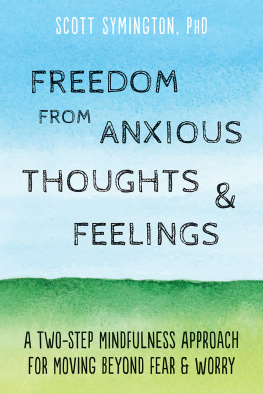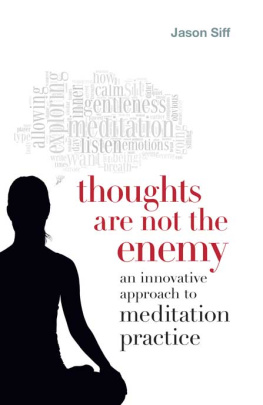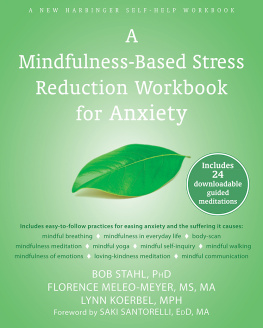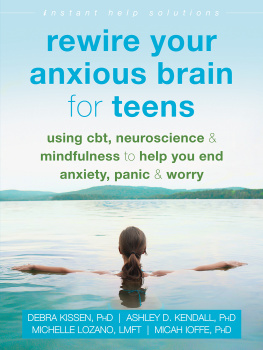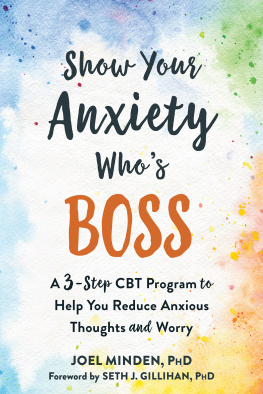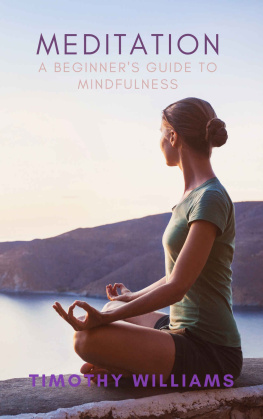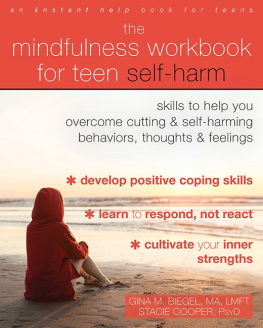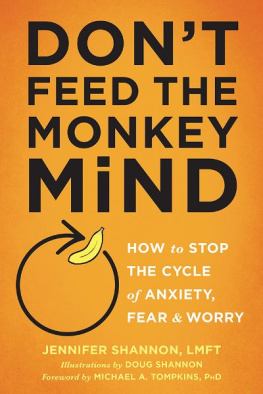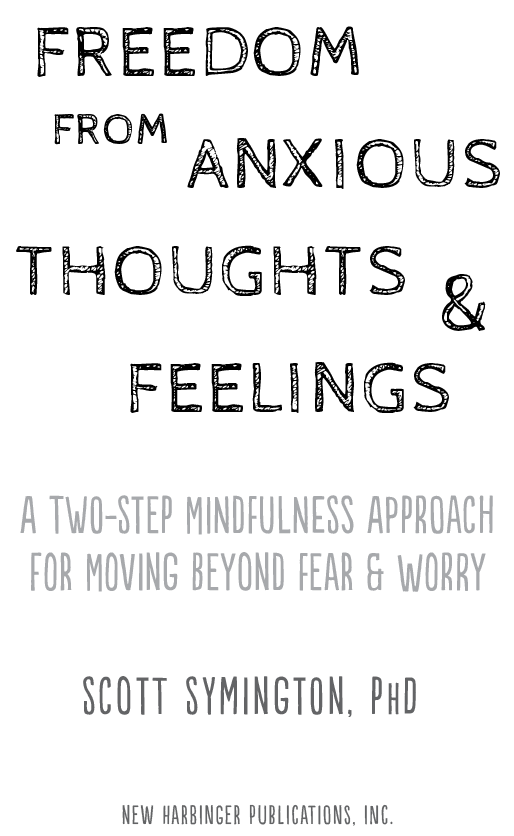Scott Symington tackles an important topic that affects almost 20 percent of all people at any given timeanxiety. In this easy-to-read book, he guides the reader through an innovative approach called the Two-Screen Method, where we learn how to deal with worries visually, and apply mindfulness principles when we need it the most. Through specific steps and well-told client stories, the readers are provided with a blueprint to ease themselves from their own anxious patterns and break the loop of fears that hold them back from achieving advancement, peace, and better relationships. A must-read for anyone!
Karen J. Miller, PhD , clinical neuropsychologist and health sciences professor at the University of California, Los Angeles
It is rare that a new book actually presents a truly new thought, perspective, or tool. Scott Symingtons Freedom from Anxious Thoughts and Feelings does all three; his groundbreaking Two-Screen Method for dealing with anxiety is broadly applicable and effective. We use his approach regularly in working with clients who are struggling with sexual issues. We find it is a tool that people can easily visualize and apply in order to accept, but put aside, interfering emotions while focusing on and pursuing spiritually sound, relationship-enhancing, and life-giving goals.
Clifford and Joyce Penner , sexual therapists, educators, and authors of The Gift of Sex
Scott Symingtons remarkable book is apt to enhance the emotional well-being of anyone who simply reads it through carefully one time. For those who wish to gain the best possible benefit of the book, he provides the tools. This is no theoretical work or an extended sales pitch for starting therapy. Symington is confident that most readers who suffer from anxiety, worry, or depression will significantly enhance the quality of their inner lives by diligently following his Two-Screen Method guidelines for about twelve weeks. He makes a convincing case and offers tremendous hope in an overly stressed world.
Anthony J. Mulkern, PhD , president of Mulkern Associates
Scott Symingtons Two-Screen Method combines several years of clinical therapeutic experience with the practical skills of mindfulness training to provide a process that creates internal psychological space within the person, which allows for the growth and development that permits us to be free of anxious thoughts and feelings. This method visually guides us toward self-acceptance by challenging distorted views of our identity, so that we can live in the present moment and find our true self and ultimate value.
James A. Van Slyke, PhD , associate professor in the department of psychology at Fresno Pacific University, and author of The Cognitive Science of Religion
Scott Symington has done a masterful and creative job in synthesizing psychological research and clinical practice into a book that is relatable, easy to understand, practical, and easy to apply. I wholeheartedly recommend this book to both therapists and their clients, as well as anyone interested in acquiring effective tools for dealing with anxiety. Indeed, freedom from problematic anxious thoughts and feelings is possible. I expect many lives will be profoundly impacted by this book.
Paul Lo, PhD , clinical psychologist and chief of the Mental Health Clinic Section at the VA Greater Los Angeles Healthcare System, Los Angeles, CA
Scott Symington uses captivating imagery to not just tell, but vividly show how to change your relationship with anxiety. The two-step approach in this book is a powerful way to evade the clutches of anxiety, and then use the momentum to experience life more deeply and take action to live your best life. I personally use this practice regularly and teach it to my clients who are delighted by how simple and profound it is.
Jeanette Lantz, PhD, BCB , founder and director of Cognitive Behavior Therapy Northwest
Living as we do in a world of fear and anxiety, Scott Symington gives us a powerful tool to face, accept, and move beyond these pervasive forces inside and around us. This book is a practical, realistic, and transformative guide. Read it, practice it, and find freedom.
Mark Labberton, PhD, MDiv , president of Fuller Theological Seminary
With this book, Scott Symington shares the secrets he has unlocked through years of real-world clinical experience with a wide variety of anxious clients. A unique combination of time-tested therapeutic techniques coupled with innovative practices, his Two-Screen Method is a valuable addition to the cognitive behavioral therapy tool chest. The easy-to-follow explanations and recommendations will open readers up to a world of sweet relief as they move through the steps and shed the fears that have held them hostage. As you climb the Freedom Ladder, prepare to trade in your exhausting anxieties for a new set of positive, life-affirming beliefs that will carry you forward into a happier ever after.
Susanne Whatley , news host on NPR affiliate KPCC in Los Angeles, CA
Publishers Note
This publication is designed to provide accurate and authoritative information in regard to the subject matter covered. It is sold with the understanding that the publisher is not engaged in rendering psychological, financial, legal, or other professional services. If expert assistance or counseling is needed, the services of a competent professional should be sought.
Distributed in Canada by Raincoast Books
Copyright 2019 by Scott Symington
New Harbinger Publications, Inc.
5674 Shattuck Avenue
Oakland, CA 94609
www.newharbinger.com
Cover design by Amy Shoup
Acquired by Jess OBrien
Edited by Kristi Hein
All Rights Reserved
Library of Congress Cataloging-in-Publication Data on file
Contents
Contents
Introduction
What Do I Do Inside My Head?
1. Seeing Your Internal World
2. Understanding Your Anxious Side Screen
3. Freedom from the Anxious Side Screen
4. Mindfulness Skills Anchor
5. The Addictive Side Screen
6. Healthy Distractions and Activities Anchor
7. The Depressive Side Screen
8. Loving Action Anchor
9. The Two-Screen Method Fully Applied
10. Q&A from the Couch
Conclusion
Acknowledgments
References
Introduction
What Do I Do Inside My Head?
Prominently displayed in our family room is a quote from St. Irenaeus of Lyons: The Glory of God is the human person fully alive. I love this quote. It speaks to our design. It helps us understand the restlessness of the human spiritthat part of self that refuses to be contained or muted. Inside us all, whether conscious or unconscious, is a burning desire to burst out onto lifes stage, proclaiming, Here I am! Its the human person fully alive.
As a clinical psychologist in full-time private practice, I have a front-row seat on those influences that cripple the human spirit, blocking people from a life fully livedchronic worrying, depressed moods, destructive patterns of behavior. In the midst of these struggles, everything may look fine on the outside. You might see a smile or all the trappings of success. But looks can be deceiving. On the inside, these people can feel embattled or hopeless or out of control. They feel trapped by and stuck with thoughts, feelings, and behaviors they dont understand and cant seem to change.
Take Laura, for example, who feels anxious in social situations. Following a conversation or social interaction, shes regularly plagued by worries of having said something stupid or others laughing behind her back. Then theres Emma, whos prone to depressed moods. A Facebook post or news of a friends engagement can automatically trigger painful thoughts of comparison: Why dont I have a boyfriend? Why does everyone else get to enjoy life except for me? As she travels down memory lane, recalling times when she felt hurt and rejected, her mood and outlook on life darken.

